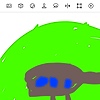HOME | DD
 ThalassoAtrox — The First Ceratopsian
ThalassoAtrox — The First Ceratopsian

#centrosaurus #triceratops #hellcreek #agathaumas #monoclonius #tyrannosaurid #tyrannosaurus #tyrannosaurusrex #hellcreekformation
Published: 2020-02-16 19:12:43 +0000 UTC; Views: 9758; Favourites: 172; Downloads: 12
Redirect to original
Description
A classic duel from the old motion picture age, a Tyrannosaurus rex (12 meters) clashing with an Agathaumas sphenocerus (9 meters), Wyoming, 67 mya.
Now, let’s see how many people won’t bother to read past this first paragraph and make unsubstantiated assumptions.
Basically, this is a “what if” scenario, humoring the idea that this ceratopsian chimera was real and a part of the late Maastrichtian megafauna of Laramidia, alongside Triceratops and Torosaurus.
If you don’t know, Agathaumas sphenocerus was a ceratopsian that seemingly had it all, a long nose horn, brow horns and a large spiky frill, combining all the best traits of its various cousins, like Triceratops and Styracosaurus. Its popularity spiked with Charles R. Knight’s iconic illustration of the animal, which showed its impressive headgear. Agathaumas became a staple in old dinosaur textbooks and stop motion movies, like The Lost World (1925), where it was depicted fighting a T. rex. Its distinctive visage also undoubtedly inspired generations of cheap cartoon depictions of ceratopsians that were mash-ups of Triceratops and Styracosaurus, in the same vein as how Pteranodon and Rhamphorhynchus frequently get merged into one generic “pterodactyl”.
Unfortunately, this magnificent dinosaur never actually existed; it was a chasmosaur/centrosaur chimera before they became a thing on Saturday Morning. The large holotype specimen (9 meters) was dug up in the Lance Formation of Wyoming and named by Edward Drinker Cope in 1872, it’s only made up of partial postcranial remains, consisting of hip bones, hip vertebrae and ribs, making it the first-named ceratopsian. Unfortunately, the giant ceratopsians of the Campanian and Maastrichtian tend to vary very little in terms of postcranial anatomy, making it difficult for workers to identify individual specimens on a taxonomic level without a skull for them to examine, which doomed the validity of Agathaumas from the start.
Skull material attributed to the genus was eventually found, showing a large nasal horn and possible brow horns, which inspired Knight’s legendary chimera. But the skull material ultimately proved to belong to Monoclonius, which has also been rendered a nomen dubium, as all of its material has been sunk into Centrosaurus and Styracosaurus, while the Agathaumas holotype is more than likely just a Triceratops, the first one to be discovered at that.
Related content
Comments: 21

👍: 0 ⏩: 0

👍: 0 ⏩: 0

👍: 0 ⏩: 0

Okay that’s actually pretty interesting. So that’s why I never heard of the ceratopsian before.
👍: 1 ⏩: 1

That's nothing. Brace yourself for what I'm about to post.
👍: 0 ⏩: 0

If you use nanotyrannus You could have called it Battle of the Not likely ps one of best work so far
👍: 0 ⏩: 0

Splendid work.
I like your modern interpretation of Agathaumas.
👍: 1 ⏩: 1

Didn't read the description, huh? The title refers to it being the first ceratopsian to be named, hence it was the one that introduced the world to ceratopsians, meaning it's the first ceratopsian within the context of our own history, not the history of the dinosaurs.
👍: 0 ⏩: 1

👍: 0 ⏩: 1

I would, but only if I feel inspired to do it. Any suggestions?
👍: 0 ⏩: 1

👍: 0 ⏩: 1

The "composite" organisms you mentioned aren't anything special. Ultrasaurus is just a generic diplodocid sauropod, and Protoavis and Archaeoraptor are essentially the same type of animal as Archeopteryx, Rhanoavis and Microraptor. I choose Agathaumas because it was more unique.
I already did old crummy drawings dedicated to outdated depictions of fossil animals. If you want to see them depicted as if they were real, just watch Walking with Dinosaurs or the Jurassic Park movies.
Labyrinthodont amphibians like Koolasuchus have remained largely unchanged since the end of the Permian. Much like crocodiles, they're riparian carnivores that saw little reason to change up their basic body plan as long as their freshwater ambush predator niche was available. If a population survived in Antarctica until let's say 66 million years ago, they would probably be more or less the same as Koolasuchus. Same with terror birds, Titanis only died out 1.8 million years ago, that's a blink of an eye in evolutionary terms. Most of the mammals that lived alongside Titanis were just slightly smaller ancestors of the familiar ice age wildlife of the late Pleistocene, so if a large terror bird still existed 10,000 years ago it would be virtually unchanged.
Well, if you read that post you probably remember how I made a point that Australia's undiscovered Mesozoic fauna would have been fairly homogeneous to the rest of Gondwana. I couldn't really come up with any reasonable speculative creatures more creative than Australian Carcharodontosaurus, or Australian Abelisaurus, or Australian Suchomimus, or Australian Tupandactylus, or Australian Amargasaurus, or Australian Sarcosuchus, etc, etc, etc..... I'm better off waiting for an actual new discovery to pop up first.
👍: 0 ⏩: 0

In a way, though, Agathaumas's spirit lives on in the form of another, much more recently described, ceratopsian-- Regaliceratops.
Brow horns? Check.
Long nose horn? Check.
Spiky frill? Check.
Lived in Maastrichtian Laramidia? Check.
Sometimes life really does imitate art!
👍: 0 ⏩: 1

Regaliceratops only resembles Agathaumas so-so, with smaller brow horns and lacking the sharp frill spikes, looking more like the sunflower dino.
👍: 0 ⏩: 1

Still, I guess it's the closest thing we've got.
👍: 0 ⏩: 0





















